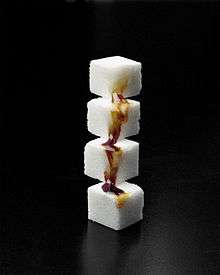Caramelization


Caramelization is the browning of sugar, a process used extensively in cooking for the resulting sweet nutty flavor and brown color. The brown colors are produced by three groups of polymers: caramelans (C24H36O18), caramlens (C36H50O25), and caramelins (C125H188O80). As the process occurs, volatile chemicals such as diacetyl are released, producing the characteristic caramel flavor.[1]
Like the Maillard reaction, caramelization is a type of non-enzymatic browning. However, unlike the Maillard reaction, caramelization is pyrolysis, as opposed to reaction with amino acids.
When caramelization involves the disaccharide sucrose, it is broken down into the monosaccharides fructose and glucose.
Process
Caramelization is a complex, poorly understood process that produces hundreds of chemical products, and includes the following types of reaction:
- equilibration of anomeric and ring forms
- sucrose inversion to fructose and glucose
- condensation reactions
- intramolecular bonding
- isomerization of aldoses to ketoses
- dehydration reactions
- fragmentation reactions
- unsaturated polymer formation.
Effects on caramelization
The process is temperature-dependent. Specific sugars each have their own point at which the reactions begin to proceed readily. Impurities in the sugar, such as the molasses remaining in brown sugar, greatly speed the reactions.
| Sugar | Temperature |
|---|---|
| Fructose | 110 °C, 230 °F |
| Galactose | 160 °C, 320 °F |
| Glucose | 160 °C, 320 °F |
| Sucrose | 160 °C, 320 °F |
| Maltose | 180 °C, 356 °F |
The caramelization reactions are also sensitive to the chemical environment. By controlling the level of acidity (pH), the reaction rate (or the temperature at which the reaction occurs readily) can be altered. The rate of caramelization is generally lowest at near-neutral acidity (pH around 7), and accelerated under both acidic (especially pH below 3) and basic (especially pH above 9) conditions.[3]
Uses in food
Caramelization is used to produce several foods, including:
- Caramel sauce, a sauce made with caramel
- Confiture de lait, caramelized, sweetened milk
- Dulce de leche, caramelized, sweetened milk
- Caramel candies
- Caramelized onions, which are used in dishes like French onion soup.
- Caramelized potatoes
- Caramelized pears[4]
- Cola, of which some brands use caramelised sugar in small amounts for colour
Note that the preparation of many "caramelized" foods also involves the Maillard reaction; particularly recipes involving protein and/or amino acid -rich ingredients.
See also
![]() Media related to caramelization at Wikimedia Commons
Media related to caramelization at Wikimedia Commons
References
- ↑ Miller, Dennis (1998). Food Chemistry: A Laboratory Manual. Wiley-Interscience. ISBN 978-0471175438.
- ↑ Food-Info on caramelization
- ↑ Villamiel, M.; del Castillo, M. D.; Corzo, N. (2006). "4. Browning Reactions". In Hui, Y. H.; Nip, W-.K.; Nollet. L. M. L.; Paliyath, G.; Simpson, B. K. Food biochemistry and food processing. Wiley-Blackwell. pp. 83–85. ISBN 978-0-8138-0378-4.
- ↑ "Caramelizing Pears | Stemilt". Stemilt. 2016-10-10. Retrieved 2016-10-27.
External links
| Look up caramelization in Wiktionary, the free dictionary. |